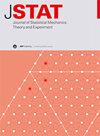Laplacian renormalization group: an introduction to heterogeneous coarse-graining
IF 1.9
3区 物理与天体物理
Q2 MECHANICS
Journal of Statistical Mechanics: Theory and Experiment
Pub Date : 2024-08-01
DOI:10.1088/1742-5468/ad57b1
引用次数: 0
Abstract
The renormalization group (RG) constitutes a fundamental framework in modern theoretical physics. It allows the study of many systems showing states with large-scale correlations and their classification into a relatively small set of universality classes. The RG is the most powerful tool for investigating organizational scales within dynamic systems. However, the application of RG techniques to complex networks has presented significant challenges, primarily due to the intricate interplay of correlations on multiple scales. Existing approaches have relied on hypotheses involving hidden geometries and based on embedding complex networks into hidden metric spaces. Here, we present a practical overview of the recently introduced Laplacian RG (LRG) for heterogeneous networks. First, we present a brief overview that justifies the use of the Laplacian as a natural extension of well-known field theories to analyze spatial disorder. We then draw an analogy to traditional real-space RG procedures, explaining how the LRG generalizes the concept of ‘Kadanoff supernodes’ as block nodes that span multiple scales. These supernodes help mitigate the effects of cross-scale correlations due to small-world properties. Additionally, we rigorously define the LRG procedure in momentum space in the spirit of the Wilson RG. Finally, we show different analyses for the evolution of network properties along the LRG flow following structural changes when the network is properly reduced.拉普拉斯重正化群:异质粗粒化入门
重正化群(RG)是现代理论物理的基本框架。它允许对许多系统进行研究,这些系统显示出具有大尺度相关性的状态,并将它们归入一组相对较小的普遍性类别。RG 是研究动态系统内组织尺度的最强大工具。然而,将 RG 技术应用于复杂网络面临着巨大挑战,这主要是由于多个尺度上的相关性错综复杂。现有方法依赖于涉及隐蔽几何的假设,并基于将复杂网络嵌入隐蔽度量空间。在此,我们将对最近推出的用于异构网络的拉普拉斯 RG(LRG)进行实用性概述。首先,我们简要概述了拉普拉斯函数作为众所周知的场理论的自然扩展来分析空间无序性的合理性。然后,我们类比了传统的实空间 RG 程序,解释了 LRG 如何将 "Kadanoff 超级节点 "的概念推广为跨越多个尺度的块节点。这些超节点有助于减轻由于小世界特性而产生的跨尺度相关性的影响。此外,我们本着威尔逊 RG 的精神,在动量空间中严格定义了 LRG 程序。最后,我们展示了在适当缩小网络结构后,网络属性沿 LRG 流程演变的不同分析。
本文章由计算机程序翻译,如有差异,请以英文原文为准。
求助全文
约1分钟内获得全文
求助全文
来源期刊
CiteScore
4.50
自引率
12.50%
发文量
210
审稿时长
1.0 months
期刊介绍:
JSTAT is targeted to a broad community interested in different aspects of statistical physics, which are roughly defined by the fields represented in the conferences called ''Statistical Physics''. Submissions from experimentalists working on all the topics which have some ''connection to statistical physics are also strongly encouraged.
The journal covers different topics which correspond to the following keyword sections.
1. Quantum statistical physics, condensed matter, integrable systems
Scientific Directors: Eduardo Fradkin and Giuseppe Mussardo
2. Classical statistical mechanics, equilibrium and non-equilibrium
Scientific Directors: David Mukamel, Matteo Marsili and Giuseppe Mussardo
3. Disordered systems, classical and quantum
Scientific Directors: Eduardo Fradkin and Riccardo Zecchina
4. Interdisciplinary statistical mechanics
Scientific Directors: Matteo Marsili and Riccardo Zecchina
5. Biological modelling and information
Scientific Directors: Matteo Marsili, William Bialek and Riccardo Zecchina

 求助内容:
求助内容: 应助结果提醒方式:
应助结果提醒方式:


